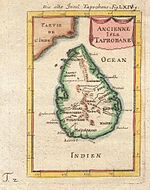Beminitiya Seya
This article needs additional citations for verification. (July 2012) |
| Beminitiya Seya | |
|---|---|
| Country | Anuradhapura Kingdom |
| Period | 103–89 BCE |
| Total deaths | Unknown |
| History of Sri Lanka | ||||||||||||||||
|---|---|---|---|---|---|---|---|---|---|---|---|---|---|---|---|---|
 | ||||||||||||||||
| Chronicles | ||||||||||||||||
| Periods | ||||||||||||||||
|
||||||||||||||||
| By Topic | ||||||||||||||||
Beminitiya Seya (Sinhala: බැමිණිතියා සාය, [bæmiɳiθija: sa:jə]), also known as the Great Famine (103–89 BCE) was a major famine which occurred in the Anuradhapura Kingdom during the rule of the Five Dravidians, shortly after overthrow of King Valagambahu.[1] For over a decade, the irrigation systems of the Anuradhapura Kingdom had failed as a result of invasion, corruption and neglect.[2]
It was undoubtedly one of the darkest eras of Sri Lankan history. Long periods of drought coupled with South Indian invasion meant that maintenance and repair of the once advanced irrigation systems of the kingdom were now completely neglected. The situation eased after the death of the last of the Five Dravidians and the return of King Valagambahu. As soon as Valagambahu returned to the throne in 89 BCE, many reforms were introduced to repair and reconstruct the ill-fated irrigation systems of the kingdom, which eventually brought the Beminitiya Seya to an end in 89 BCE. To this day, Valagambahu is regarded as one of Sri Lanka's greatest kings.[2]
The famine is mentioned a number of times in the stories contained in the "Sihalavatthu Pakarana", the oldest work of Sri Lankan literature. In this work, it is related that many monks left the island during the famine to India or the Maldives.[3]
References
[edit]- ^ Shaw, Rajib; Nguyen, Huy (2011). Droughts in Asian Monsoon Region. Emerald Group Publishing. p. 97. ISBN 9780857248640.
{{cite book}}: CS1 maint: multiple names: authors list (link) - ^ a b "Our True Heroes". Archived from the original on 2007-09-28. Retrieved 2007-09-05.
- ^ D. Amarasiri Weeraratne, Sihalavatthu Pakarana: Book of ancient Sinhala religious stories The Island, Thursday 07th December, 2001 [1]
